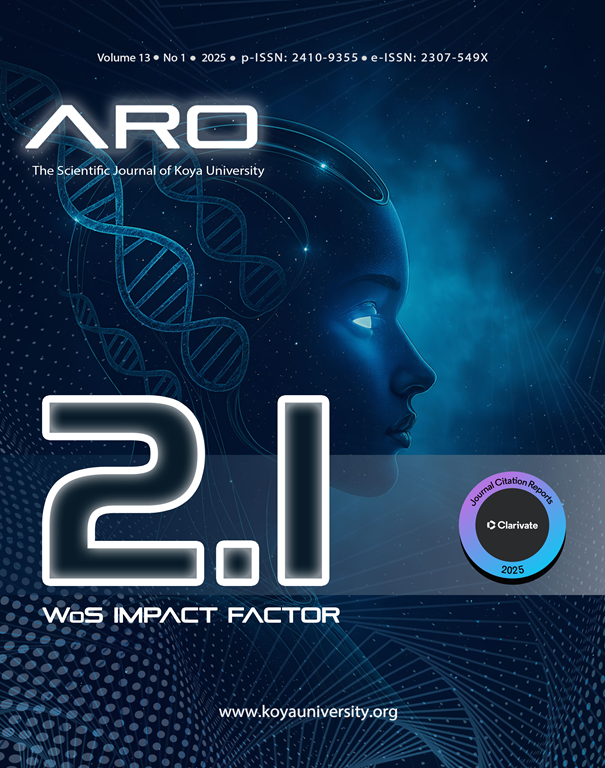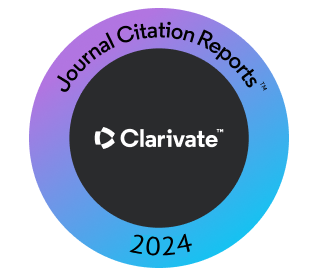Synthesis and Analysis of the Density States and Optical Characteristics of Se100-X TeX Semiconductors
DOI:
https://doi.org/10.14500/aro.11955Keywords:
Amorphous structure, Chalcogenide, Density of the extended, Electrical measurements, Localized, Optical propertiesAbstract
The widespread commercial importance of selenium makes it an interesting element. It serves as an effective host matrix for chalcogenide alloys. However, pure selenium has a short lifetime and poor sensitivity. Therefore, specific chemical elements, such as tritium, have been used to overcome this problem. Se-Te alloys are preferred over selenium for their numerous advantages, such as increased electrical sensitivity, thermal stability, and applications in xerography. In this manuscript, the effects of partially substituting tellurium for selenium are studied for amorphous Se100-x Tex chalcogenide alloys prepared by melt quenching and spraying procedures to produce bulk and thin films, respectively, with varying tellurium concentrations (x = 10, 20, 30, and 40). X-ray diffraction of samples with different concentrations revealed that all samples had an amorphous (glassy) structure. Continuous electrical conductivity is also studied to determine the conduction mechanisms, effective energies, and densities of localized and extended states. The results of electrical conductivity measurements confirm the existence of two conduction modes (extended-state conduction at high temperatures and localized state conduction at intermediate and low temperatures in the tails of the conduction and valence bands). It is also found that the density of states, local and extended state coefficients, and activation energies are significantly affected by the partial substitution of selenium with tellurium. The optical properties of the Se₁₀₀₋ₓTeₓ films are studied using ultraviolet-visible spectroscopy, and it is found that the overall absorption increases while the energy gap decreases with increasing tellurium concentration.
Downloads
References
Abd-Elrahman, M.I., Khafagy, Rasha M., Zaki, S.A., and Hafiz, M.M., 2013. Effect of composition on the optical constants of Se100-x Tex thin films. Journal of Alloys and Compounds, 571, pp.118-122. DOI: https://doi.org/10.1016/j.jallcom.2013.03.215
Abdulateef, A.N., Alsudani, A., Chillab, R.K., Jasim, K.A., and Shaban, A.H., 2020. Calculating the mechanisms of electrical conductivity and energy density of states for Se85 Te10 Sn5-x Inx glasses materials. Journal of Green Engineering, 10, pp.5487-5503.
Ahmed, B.A., Mohammed, J.S., Fadhil, R.N., Jasim, K.A., Shaban, A.H., and Al Dulaimi, A.H., 2022. The dependence of the energy density states on the substitution of chemical elements in the Se6 Te4-x Sbx thin film. Chalcogenide Letters, 19, pp.301-308. DOI: https://doi.org/10.15251/CL.2022.194.301
Al-Agel, F.A., 2011. Influence of composition on electrical and optical properties of new chalcogenide thin films from Ge-Se-Tl system. Optics and Laser Technology, 43, pp.781-786. DOI: https://doi.org/10.1016/j.optlastec.2010.11.011
Al-Agel, F.A., 2013. Optical and structural properties of amorphous Sex Te100-x aligned nanorods. Nanoscale Research Letters, 9, pp.520. DOI: https://doi.org/10.1186/1556-276X-8-520
Borisova, Z.U.U., 1981. In: Adashko, J.G., Ed. Glassy Semiconductors. Springer Science and Business Media, LLC. DOI: https://doi.org/10.1007/978-1-4757-0851-6
Chaudhri, M., Vohra, A., and Chakarvarti, S.K., 2008. Fabrication of Zn/ Cd-Se micro heterostructures by electrochemical deposition in the pores of polycarbonate track-etch membranes and their characterization. Physica E: Low-Dimensional Systems and Nanostructures, 40, pp.849-851. DOI: https://doi.org/10.1016/j.physe.2007.10.075
Chillab, R.K., Jahil, S.S., Wadi, K.M., Jasim, K.A., and Shaban, A.H., 2021. Fabrication of Ge30 Te 70-x Sbx glasses alloys and studying the effect of partial substitution on d.C electrical energy parameters. Key Engineering Materials, 900, pp.163-171. DOI: https://doi.org/10.4028/www.scientific.net/KEM.900.163
Cohen, M.H., Fritzsche, H., and Ovshinsky, S.R., 1969. Simple band model for amorphous semiconducting alloys. Physical Review Letters, 22(20), pp.1065-1068. DOI: https://doi.org/10.1103/PhysRevLett.22.1065
Elliott, G.R., Murugan, G.S., Wilkinson, J.S., Zervas, M.N., and Hewak, D.W., 2010. Chalcogenide glass microsphere laser. Optics Express, 18, pp.26720-26727. DOI: https://doi.org/10.1364/OE.18.026720
Elliott, S.R., 2015. Chalcogenide phase-change materials: Past and future. International Journal of Applied Glass Science, 6, pp.15-18. DOI: https://doi.org/10.1111/ijag.12107
Elliott, S.R., and Steel, A.T., 1986. Mechanism for doping in Bi chalcogenide glasses. Physical Review Letters, 57, pp.1316-1319. DOI: https://doi.org/10.1103/PhysRevLett.57.1316
Faraj, M.G., 2022. Effect of substrate temperature on the electrical properties of al-doped zinc oxide films deposited on polyethylene terephthalate. Aro-The Scientific Journal of Koya University, 10, pp.131-133. DOI: https://doi.org/10.14500/aro.11086
Farid, A.S., Fadel, M., and Abd El-Wahabb, E., 2019. AC electrical conductivity and dielectric relaxation behavior of amorphous Se36In31Cu33 thin films. Phase Transitions, 92, pp.1031-1042. DOI: https://doi.org/10.1080/01411594.2019.1679370
Flasck, R., Izu, M., Sapru, K., Anderson, T., Ovshinsky, S.R., and Fritzsche, H., 1991. Optical and electronic properties of modified amorphous materials. Disordered Materials, pp.51-53. DOI: https://doi.org/10.1007/978-1-4684-8745-9_13
Frumar, M., and Tichý, L., 1987. N-type conductivity in chalcogenide glasses and layers. Journal of Non-Crystalline Solids, 97-98, pp.1139-1146. DOI: https://doi.org/10.1016/0022-3093(87)90273-0
Hamad, N.H., Faraj, M.G., and Taha, A.H., 2023. Structural and optical properties of cadmium sulfide-doped silver deposited on glass and polymer substrates by chemical spray pyrolysis. Aro-The Scientific Journal of Koya University, 11, pp.32-37. DOI: https://doi.org/10.14500/aro.11097
Jacques, I.P., 1975. Optical Processes in Semiconductors. Dove Publications lnc., New York.
Jasim, K.A., Alwan, T.J., Al-Lamy, H.K., and Mansour, H.L, 2011. Improvements of superconducting properties of hg0.6pb0.25sb0.15ba2ca2cu3o8+δ ceramic by controlling the sintering time. Journal of Superconductivity and Novel Magnetism, 24, pp.1963-1966. DOI: https://doi.org/10.1007/s10948-011-1153-1
Jouanne, M., Morhange, J.F., Dynowska, E., Łusakowska, E., Szuszkiewicz, W., Molenkamp, L.W., and Karczewski, G., 2004. Structure characterization of MBE-grown (Zn, Cr) Se layers. Journal of Alloys and Compounds, 32, pp.92-99. DOI: https://doi.org/10.1016/j.jallcom.2004.05.039
Khudhair, N.H., and Jasim, K.A., 2023. Study the effect of tin on the energy density of states Se60Te40-xSnx chalcogenide glass. AIP Conference Proceedings, 2769, p.020062. DOI: https://doi.org/10.1063/5.0129373
Khudhair, N.H., and Jasim, K.A.A., 2023. Study of the effectiveness of tin on the thermal conductivity coefficient and electrical resistance of Se60Te40-xSnx chalcogenide glass. Ibn AL-Haitham Journal for Pure and Applied Sciences, 36, pp.149-157. DOI: https://doi.org/10.30526/36.1.2892
Lanyon, H.P.D., 1964. Optical and electrical properties of selenium‐tellurium alloys. Journal of Applied Physics. 35, pp.1516-1523. DOI: https://doi.org/10.1063/1.1713659
Lou, S., Zhou, C., Xu, W., Wang, H., Zhou, S., Shen, H., and Li, L.S., 2012. Facile synthesis of water-soluble Znx Cd1−x Se nanocrystals via a two-phase cation exchange method. Chemical Engineering Journal, 211-212, pp.104-111. DOI: https://doi.org/10.1016/j.cej.2012.09.049
Lucas, P., Coleman, G.J., Jiang, S., Luo, T., and Yang, Z., 2015. Chalcogenide glass fibers: Optical window tailoring and suitability for bio-chemical sensing. Optical Materals, 47, pp.530-536. DOI: https://doi.org/10.1016/j.optmat.2015.06.034
Lucas, P., Conseil, C., Yang, Z., Hao, Q., Cui, S., Boussard-Pledel, C., Bureau, B.,Gascoin, F.,Caillaud, C., Gulbiten, O., Baruah, P., Guizouarn, T., Li, Q., and Lucas, J., 2013. Thermoelectric bulk glasses based on the Cu-As-Te-Se system. Journal of Materials Chemsitry A, 1, p.31. DOI: https://doi.org/10.1039/c3ta11117b
Mahdi, S.H., Jassim, W.H., Hamad, I.A., and Jasima, K.A., 2017. Epoxy/ silicone rubber blends for voltage insulators and capacitors applications. Energy Procedia, 119, pp.501-506. DOI: https://doi.org/10.1016/j.egypro.2017.07.059
Mehta, N., 2020. Recent applications of chalcogenide glasses (ChGs) based sensors. In: Advances in Modern Sensors. IOP Science, United Kingdom. DOI: https://doi.org/10.1088/978-0-7503-2707-7ch4
Mohammed, J.S., Nsaif, F.K., Jawad, Y.M., Jasim, K.A., and Al Dulaimi, A.H., 2023. Investigating the optical and electrical characteristics of As60Cu40 xSex thin films prepared using pulsed laser deposition method. Chalcogenide Letters, 20, pp.449-458. DOI: https://doi.org/10.15251/CL.2023.207.449
Mohammed, L.A., and Jasim, K.A., 2019. Improvement the superconducting properties of TlBa2 Ca2 Cu 3x Nix O9 δ superconducting compound by partial substitution of copper with nickel oxide on the. Energy Procedia, 157, pp.135–142. DOI: https://doi.org/10.1016/j.egypro.2018.11.173
Mott, N.F., Davis, E.A., and Street, R.A., 1975. States in the gap and recombination in amorphous semiconductors. Philosophical Magazine, 32, pp.961-996. DOI: https://doi.org/10.1080/14786437508221667
Patil, V., Shahane, G., Sutrave, D., Raut, B., and Deshmukh, L., 2004. Photovoltaic properties of N-CdS1-xTex thin film/oxysulphide photoelectrochemical solar cells prepared by chemical bath deposition. Thin Solid Films, 446, pp.1-5. DOI: https://doi.org/10.1016/S0040-6090(03)01106-4
Pattanayak, P., and Asokan, S., 2005. Signature of a silver phase percolation threshold in microscopically phase separated ternary Ge0.15Se0.85-XAgx (0≥x≥0.20) glasses. Journal of Applied Physics, 97, pp.13-16. DOI: https://doi.org/10.1063/1.1827341
Reddy, K.V., and Bhatnagar, A.K., 1992. Electrical and optical studies on amorphous Se-Te alloys. Journal of Physics D: Applied Physics, 25, pp.1810. DOI: https://doi.org/10.1088/0022-3727/25/12/017
Street, R.A., and Mott, N.F., 1975. States in the gap in glassy semiconductors. Physical Review Letters, 35, pp.1293-1296. DOI: https://doi.org/10.1103/PhysRevLett.35.1293
Tong, X.C., 2014. Advanced Materials for Integrated Optical Waveguides. Springer Science and Business Media, Germany. DOI: https://doi.org/10.1007/978-3-319-01550-7_11
Yang, Z., Fah, M.K., Reynolds, K.A., Sexton, J.D., Riley, M.R., Anne, M.L., Bureau, B., and Lucas, P., 2010. Electrophoretic detection of bio-molecules using conducting chalcogenide glass sensors. Optics Express, 18, pp.26754-26759. DOI: https://doi.org/10.1364/OE.18.026754
Yang, Z., Gulbiten, O., Lucas, P., Luo, T., and Jiang, S., 2011. Long-wave infrared-transmitting optical fibers. Journal American Ceramic Society, 94, pp.1761-1765. DOI: https://doi.org/10.1111/j.1551-2916.2010.04313.x
Downloads
Published
How to Cite
Issue
Section
License
Copyright (c) 2025 Kassim M. Wadi, Maher A. Hasan, Shaymaa H. Aneed, Mohammad G. Faraj, Kareem A. Jasim

This work is licensed under a Creative Commons Attribution-NonCommercial-ShareAlike 4.0 International License.
Authors who choose to publish their work with Aro agree to the following terms:
-
Authors retain the copyright to their work and grant the journal the right of first publication. The work is simultaneously licensed under a Creative Commons Attribution License [CC BY-NC-SA 4.0]. This license allows others to share the work with an acknowledgement of the work's authorship and initial publication in this journal.
-
Authors have the freedom to enter into separate agreements for the non-exclusive distribution of the journal's published version of the work. This includes options such as posting it to an institutional repository or publishing it in a book, as long as proper acknowledgement is given to its initial publication in this journal.
-
Authors are encouraged to share and post their work online, including in institutional repositories or on their personal websites, both prior to and during the submission process. This practice can lead to productive exchanges and increase the visibility and citation of the published work.
By agreeing to these terms, authors acknowledge the importance of open access and the benefits it brings to the scholarly community.
Accepted 2025-04-20
Published 2025-05-05
















 ARO Journal is a scientific, peer-reviewed, periodical, and diamond OAJ that has no APC or ASC.
ARO Journal is a scientific, peer-reviewed, periodical, and diamond OAJ that has no APC or ASC.